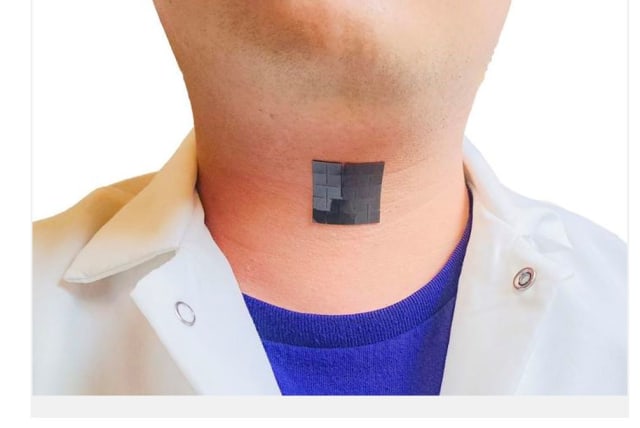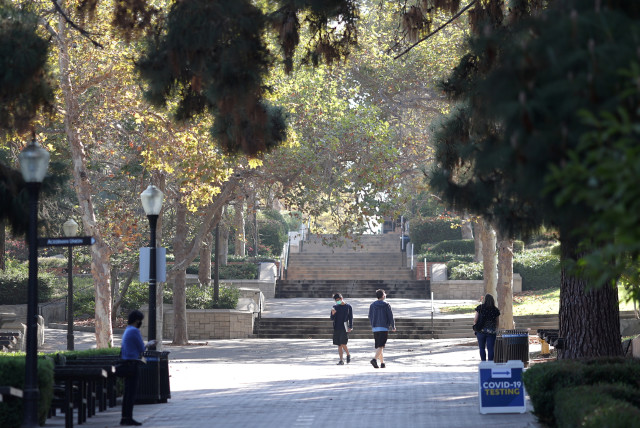New wearable neck patch invention allows people to speak with no vocal cords

Looking forward, the research team plans to continue enlarging the vocabulary of the device through machine learning and to test it in people with speech disorders.
A person can lose their voice (dysphonia) from a cold, speaking constantly as a teacher, singing at the top of their voice at a concert, or from allergies – but they always recover.
However, there are diseases that cause vocal cord paralysis, in which you can’t control the movement of the muscles that control your voice when the nerve impulses to your voice box (larynx) are disrupted. This results in chronic paralysis of the vocal cord muscles.
Vocal cord paralysis can make it hard to speak and even breathe; that’s because your vocal cords not only produce sound but also protect the airway by preventing food, drink, and even your saliva from entering your windpipe and making you choke. Possible causes of vocal cord paralysis include certain cancers, nerve damage during surgery, cervical spine injuries, and even serious viral infections.
However, there is hope for people who have lost their voice chronically or permanently – a new wearable, adhesive device using artificial intelligence developed by bioengineers at the University of California at Los Angeles (UCLA).They invented a soft, thin, stretchy device measuring just over 6.5 sq. cm. that can be attached to the skin outside the throat to help people with dysfunctional vocal cords regain their voice function.
The invention has just been disclosed in the prestigious journal Nature Communications, under the title “Speaking without vocal folds using a machine-learning-assisted wearable sensing-actuation system.”
The bioelectric system, developed by Prof. Jun Chen at UCLA’s Samueli School of Engineering and his colleagues, is able to detect movement in a person’s larynx muscles and translate those signals into audible speech with the assistance of machine-learning technology with nearly 95% accuracy.
This is the latest breakthrough in Chen’s efforts to help those with disabilities. His team previously developed a wearable glove capable of translating American Sign Language (ASL) into English speech in real time to help users of ASL communicate with those who don’t know how to sign.
The patch's design
The tiny new patch-like device consists of two components. One, a self-powered sensing component, detects and converts signals generated by muscle movements into high-fidelity, analyzable electrical signals. These electrical signals are then translated into speech signals using a machine-learning algorithm. The other, an actuation component, turns those speech signals into the desired voice expression.
The two components each contain two layers: a layer of biocompatible silicone compound polydimethylsiloxane (PDMS) with elastic properties and a magnetic induction layer made of copper induction coils. Sandwiched between the two components is a fifth layer containing PDMS mixed with micromagnets, which generates a magnetic field.
Using a soft magnetoelastic sensing mechanism developed by Chen’s team three years ago, the device can detect changes in the magnetic field when it is changed by mechanical forces – in this case, the movement of laryngeal muscles. The embedded serpentine induction coils in the magnetoelastic layers help generate high-fidelity electrical signals for sensing purposes.
Measuring 3 cm. on each side, the device weighs about 7 gr. and is just 1.5 mm. thick. With double-sided biocompatible tape, it can easily adhere to an individual’s throat near the location of the vocal cords and can be reused by reapplying tape as needed.
Voice disorders are prevalent across all ages and demographic groups; research has shown that almost a third of people will experience at least one such disorder in their lifetime. Yet with therapeutic approaches, such as surgical interventions and voice therapy, voice recovery can stretch from three months to a year, with some invasive techniques requiring a significant period of mandatory voice rest after surgery.
“Existing solutions such as handheld electro-larynx devices and tracheoesophageal-puncture procedures can be inconvenient, invasive or uncomfortable,” said Chen, who has been named one the world’s most highly cited researchers five years in a row. “This new device presents a wearable, non-invasive option capable of assisting patients in communicating during the period before treatment and during the post-treatment recovery period for voice disorders.”
The researchers tested the wearable technology on eight healthy adults in their experiments. They collected data on laryngeal muscle movement and used a machine-learning algorithm to correlate the resulting signals to certain words and then chose a corresponding output voice signal through the device’s actuation component.
The research team showed how accurate the system is by having the participants pronounce five sentences – both aloud and voicelessly – including “Hi, Rachel, how are you doing today?” and “I love you!” The overall prediction accuracy of the model was 94.68%, with the participants’ voice signal amplified by the actuation component, demonstrating that the sensing mechanism recognized their laryngeal movement signal and matched the corresponding sentence the participants wished to say.
Looking forward, the research team plans to continue enlarging the vocabulary of the device through machine learning and to test it in people with speech disorders.
Jerusalem Post Store
`; document.getElementById("linkPremium").innerHTML = cont; var divWithLink = document.getElementById("premium-link"); if (divWithLink !== null && divWithLink !== 'undefined') { divWithLink.style.border = "solid 1px #cb0f3e"; divWithLink.style.textAlign = "center"; divWithLink.style.marginBottom = "15px"; divWithLink.style.marginTop = "15px"; divWithLink.style.width = "100%"; divWithLink.style.backgroundColor = "#122952"; divWithLink.style.color = "#ffffff"; divWithLink.style.lineHeight = "1.5"; } } (function (v, i) { });

